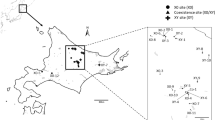Abstract
The karyotypes of Warramaba virgo and the two bisexual species which gave rise to it, by hybridization, have been studied by the C- and G-banding techniques. W. virgo consists of a number of clones which differ by a limited number of inversions, translocations and fusions and also in C-banding pattern. In general, each local population consists of a single clone, although instances are known where two clones exist at the same locality. A total of fifteen cytological clones are here recognised and described. Some of these are known from single localities, while others have been found at several collecting sites in the same general area. The differences between them in banding pattern are relatively minor, i.e. the architecture of the karyotype has been highly conserved. A total of 50 C-bands have been recognised in W. virgo, but some of these are only present in a single clone and most clones have 39–40 bands. Most of these are centromeric or interstitial; a few are terminal (telomeric) in the short arms. There are three types of bands, dark-staining centromeric ones, intermediate ones that are somewhat less densely staining, and lighter ones that appear “grey” even after successful C-banding. The C-banding pattern of W. virgo provides additional evidence for its origin by hybridization between the bisexual species “P196” and “P169”. It is possible that W. virgo arose only “once” (i.e. from one or more matings between P196 and P169 individuals in the same deme, within a few generations). However, two clones (Zanthus and Boulder), which are themselves closely similar, differ so much in banding pattern from all others that they may have arisen independently.
Similar content being viewed by others
References
Atchley, W.R.: Evolutionary consequences of parthenogenesis: evidence from the Warramaba virgo complex. Proc. nat. Acad. Sci. (Wash.) 74, 1130–1134 (1977)
Hewitt, G.M.: A new hypothesis for the origin of the parthenogenetic grasshopper Moraba virgo. Heredity 34, 117–123 (1975)
John, B., King, M.: Heterochromatin variation in Cryptobothrus chrysophorus. II. Patterns of C-banding. Chromosoma (Berl.) 65, 59–79 (1977)
Key, K.H.L.: A generic and suprageneric classification of the Morabinae (Orthoptera: Eumastacidae) with description of the type species and a bibliography of the sub-family. Austral. J. Zool., Suppl. Ser. No. 37, 1–185 (1976)
Parker, E.D. Jr., Selander, R.K.: The organisation of genetic diversity in the parthenogenetic lizard Cnemidophorus tesselatus. Genetics 84, 791–805 (1976)
Shaw, D.D., Webb, G.C., Wilkinson, P.: Population cytogenetics of the genus Caledia (Orthoptera: Acridinae). II. Variation in the pattern of C-banding. Chromosoma (Berl.) 56, 169–190 (1976)
Smith, G.P.: Evolution of repeated DNA sequence by unequal crossover. Science 191, 528–535 (1976)
Suomalainen, E., Saura, A., Lokki, J.: Evolution of parthenogenetic insects. Evol. Biol. 9, 209–227 (1976)
Webb, G.C.: Chromosome organisation in the Australian plague locust, Chortoicetes terminifera. I. Banding relationships of the normal and supernumerary chromosomes. Chromosoma (Berl.) 55, 229–246 (1976)
White, M.J.D.: Animal cytology and evolution, 1st edit. Cambridge: University Press 1945
White, M.J.D.: Further studies on the cytology and distribution of the Australian parthenogenetic grasshopper, Moraba virgo. Rev. Suisse Zool. 73, 383–398 (1966)
White, M.J.D.: Chromosomal rearrangements and speciation in animals. Ann. Rev. Genet. 3, 75–98 (1969)
White, M.J.D.: The karyotype of the parthenogenetic grasshopper Xiphidiopsis lita (Orthoptera, Tettigoniidae). Caryologia (Firenze) (in press, 1979)
White, M.J.D., Cheney, J., Key, K.H.L.: A parthenogenetic species of grasshopper with complex structural heterozygosity (Orthoptera: Acridoidea). Austral. J. Zool. 11, 1–19 (1963)
White, M.J.D., Contreras, N.: Cytogenetics of the parthenogenetic grasshopper Warramaba (formerly Moraba) virgo and its bisexual relatives. V. Interaction of W. virgo and a bisexual species in geographic contact. Evolution (Lawrence, Kans.) (in press, 1979)
White, M.J.D., Contreras, N., Cheney, J., Webb, G.C.: Cytogenetics of the parthenogenetic grassidisation studies. Chromosoma (Berl.) 61, 127–148 (1977)
White, M.J.D., Webb, G.C.: Origin and evolution of parthenogenetic reproduction in the grasshopper Moraba virgo (Eumastacidae: Morabinae). Austral. J. Zool. 16, 647–671 (1968)
White, M.J.D., Webb, G.C., Cheney, J.: Cytogenetics of the parthenogenetic grasshopper Moraba virgo and its bisexual relatives. I. A new species of the virgo group with a unique sex chromosome mechanism. Chromosoma (Berl.) 40, 199–212 (1973)
Author information
Authors and Affiliations
Rights and permissions
About this article
Cite this article
Webb, G.C., White, M.J.D., Contreras, N. et al. Cytogenetics of the parthenogenetic grasshopper Warramaba (formerly Moraba) virgo and its bisexual relatives. Chromosoma 67, 309–339 (1978). https://doi.org/10.1007/BF00285964
Received:
Accepted:
Issue Date:
DOI: https://doi.org/10.1007/BF00285964




